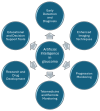Lights and Shadows on Artificial Intelligence in Glaucoma: Transforming Screening, Monitoring, and Prognosis
- PMID: 40217589
- PMCID: PMC11989555
- DOI: 10.3390/jcm14072139
Lights and Shadows on Artificial Intelligence in Glaucoma: Transforming Screening, Monitoring, and Prognosis
Abstract
Background/Objectives: Artificial intelligence (AI) is increasingly being integrated into medicine, including ophthalmology, owing to its strong capabilities in image recognition. Methods: This review focuses on the most recent key applications of AI in the diagnosis and management of, as well as research on, glaucoma by performing a systematic review of the latest papers in the literature. Results: In glaucoma, AI can help analyze large amounts of data from diagnostic tools, such as fundus images, optical coherence tomography scans, and visual field tests. Conclusions: AI technologies can enhance the accuracy of glaucoma diagnoses and could provide significant economic benefits by automating routine tasks, improving diagnostic accuracy, and enhancing access to care, especially in underserved areas. However, despite these promising results, challenges persist, including limited dataset size and diversity, class imbalance, the need to optimize models for early detection, and the integration of multimodal data into clinical practice. Currently, ophthalmologists are expected to continue playing a leading role in managing glaucomatous eyes and overseeing the development and validation of AI tools.
Keywords: artificial intelligence; deep learning; fundus imaging; glaucoma; machine learning; optical coherence tomography; visual field test.
Conflict of interest statement
The authors declare that no competing interests exist.
Figures
Similar articles
-
Artificial intelligence in ophthalmology: opportunities, challenges, and ethical considerations.Med Hypothesis Discov Innov Ophthalmol. 2025 May 10;14(1):255-272. doi: 10.51329/mehdiophthal1517. eCollection 2025 Spring. Med Hypothesis Discov Innov Ophthalmol. 2025. PMID: 40453785 Free PMC article. Review.
-
Novel Approaches for the Early Detection of Glaucoma Using Artificial Intelligence.Life (Basel). 2024 Oct 28;14(11):1386. doi: 10.3390/life14111386. Life (Basel). 2024. PMID: 39598184 Free PMC article. Review.
-
The upcoming role of Artificial Intelligence (AI) for retinal and glaucomatous diseases.J Optom. 2022;15 Suppl 1(Suppl 1):S50-S57. doi: 10.1016/j.optom.2022.08.001. Epub 2022 Oct 8. J Optom. 2022. PMID: 36216736 Free PMC article. Review.
-
Artificial Intelligence Algorithms to Diagnose Glaucoma and Detect Glaucoma Progression: Translation to Clinical Practice.Transl Vis Sci Technol. 2020 Oct 15;9(2):55. doi: 10.1167/tvst.9.2.55. eCollection 2020 Oct. Transl Vis Sci Technol. 2020. PMID: 33117612 Free PMC article.
-
Artificial Intelligence Applications in Ophthalmology.JMA J. 2025 Jan 15;8(1):66-75. doi: 10.31662/jmaj.2024-0139. Epub 2024 Sep 13. JMA J. 2025. PMID: 39926073 Free PMC article. Review.
Cited by
-
Artificial intelligence in ophthalmology: opportunities, challenges, and ethical considerations.Med Hypothesis Discov Innov Ophthalmol. 2025 May 10;14(1):255-272. doi: 10.51329/mehdiophthal1517. eCollection 2025 Spring. Med Hypothesis Discov Innov Ophthalmol. 2025. PMID: 40453785 Free PMC article. Review.
-
The Role of Artificial Intelligence in Predicting the Progression of Intraocular Hypertension to Glaucoma.Life (Basel). 2025 May 27;15(6):865. doi: 10.3390/life15060865. Life (Basel). 2025. PMID: 40566519 Free PMC article.
References
-
- Gallo Afflitto G., Aiello F., Cesareo M., Nucci C. Primary Open Angle Glaucoma Prevalence in Europe: A Systematic Review and Meta-Analysis. J. Glaucoma. 2022;31:783–788. - PubMed
-
- Tham Y.C., Li X., Wong T.Y., Quigley H.A., Aung T., Cheng C.Y. Global Prevalence of Glaucoma and Projections of Glaucoma Burden through 2040. Ophthalmology. 2014;121:2081–2090. - PubMed
-
- Steinmetz J.D., Bourne R.R.A., Briant P.S., Flaxman S.R., Taylor H.R.B., Jonas J.B., Abdoli A.A., Abrha W.A., Abualhasan A., Abu-Gharbieh E.G., et al. Causes of blindness and vision impairment in 2020 and trends over 30 years, and prevalence of avoidable blindness in relation to VISION 2020: The Right to Sight: An analysis for the Global Burden of Disease Study. Lancet Glob. Health. 2021;9:e144–e160. - PMC - PubMed
Publication types
LinkOut - more resources
Full Text Sources



